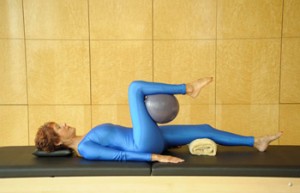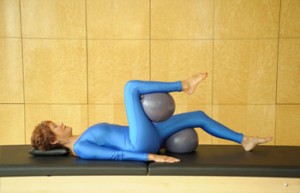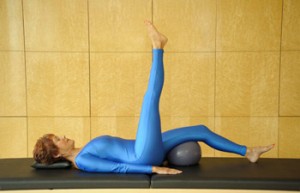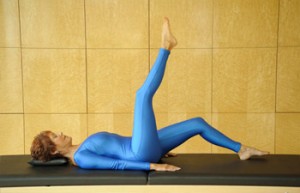Pilates for Hip and Knee Syndromes and Arthroplasties
Introduction
This section will display several of the Pilates mat movements from the book. You will find the exercise, it’s description, pictures and how the movement changes overtime from the very modified to ideal. The goal is that you can see variations of the movement with regressions or progressions to meet the needs of the individual depending on their available range of motion, flexibility and stability whether for a hip or knee syndrome or post-operative arthroplasty.
To accommodate the needs of a client with a hip or knee syndrome, one would chose a variation as shown below that meets the needs of the individual based upon their range of motion and ability to stabilize and maintain alignment.
Sample exercise
The sample exercise below (Single Leg Circle) is pictured with variations and modifications demonstrating the multiple ways that the exercise can be performed based upon the individual needs of the client.
Disclaimer:
All exercises should be performed under the guidance of a qualified Pilates instructor and with referral from the operative physician. The client’s needs, restrictions, and ROM recommendations should be specified by the physician and followed accordingly. These guidelines may vary from the protocols noted in “Pilates for Hip and Knee Syndromes and Arthroplasties”. The protocols should be modified based on the individual’s needs and the surgeon’s preferences.
Single Leg Circle
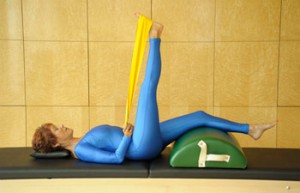 Timeline: 6 weeks to 3 months post-op Timeline: 6 weeks to 3 months post-opAppropriate for: knee and hip Location: a raised mat, hip height |
Instructions
|
||
|
|||
 Timeline: 3 to 6 months post-op Timeline: 3 to 6 months post-opAppropriate for: knee and hip Location: a floor mat or a raised mat as needed; a raised mat for a bilateral knee or hip replacement as needed |
Instructions
|
||
|
|||
 Timeline: 6 months and beyond post-op Timeline: 6 months and beyond post-opAppropriate for: knee and hip Location: a floor mat or a raised mat as needed |
Instructions
|
||
Look for (Encourage):
- Working leg engaged hip to toe
- Shoulders gliding toward the hips as if suspenders were hooked to the bottom tips of the shoulder blades and attached to the hips
- A secure hold maintained on the exercise band
- Stable core and torso and leg working with precision and control
- Open collarbones as if taffy were strung across the shoulders
- Elbows lengthening on the mat toward the feet when using the exercise band
- Arms long by the sides of the body when not using the exercise band
- Disassociation of the head of the femur from the acetablum (stable pelvis with a flowing movement of the working leg
Be aware of (Prevent):
- Lower lumbar spine arching away from the mat and loss of the neutral spine
- Movement of the pelvis and lack of disassociation of the hip from the pelvis
Primary Muscles Activated:
The primary muscles activated depend on the chosen option. Abdominals, rectus femoris, vastus medialis, vastus intermedius, vastus lateralis, sartorius, pectineus, iliopsoas, gluteus maximus, gluteus medius, gluteus minimus, biceps femoris, semitendinosus, semimembra- nosus, tensor fasciae latae, adductor magnus, adductor longus, adductor brevis, gracilis, sartorius, popliteus, gastrocnemius, plantaris

